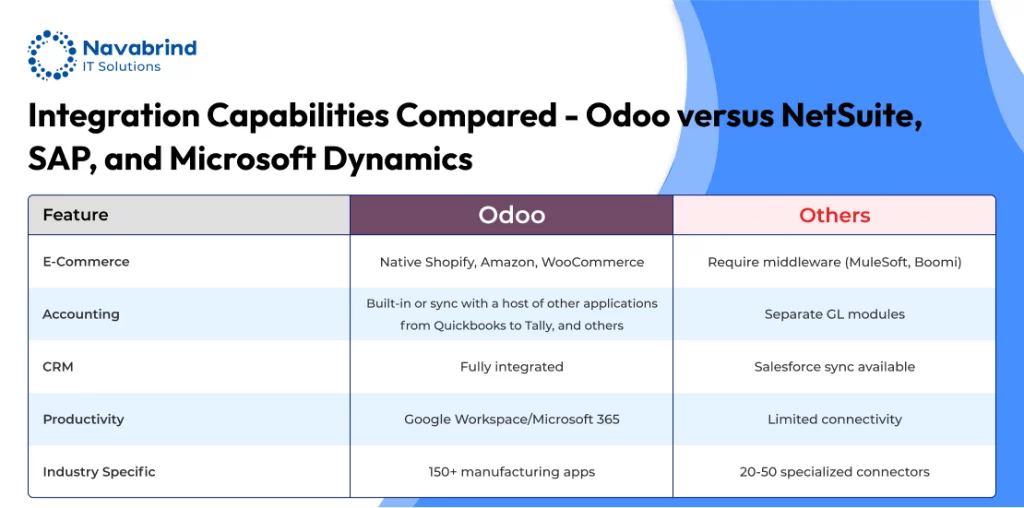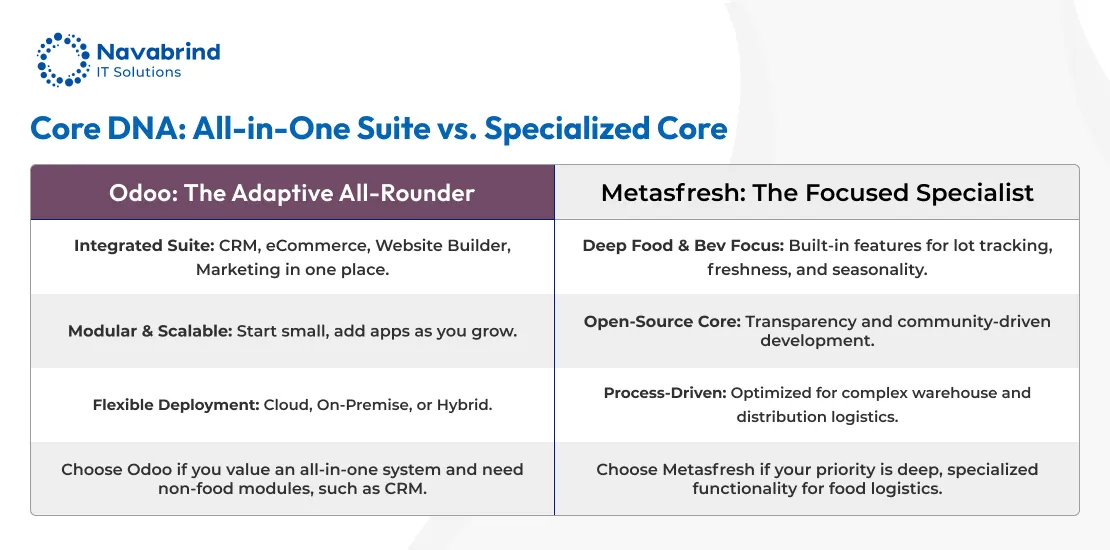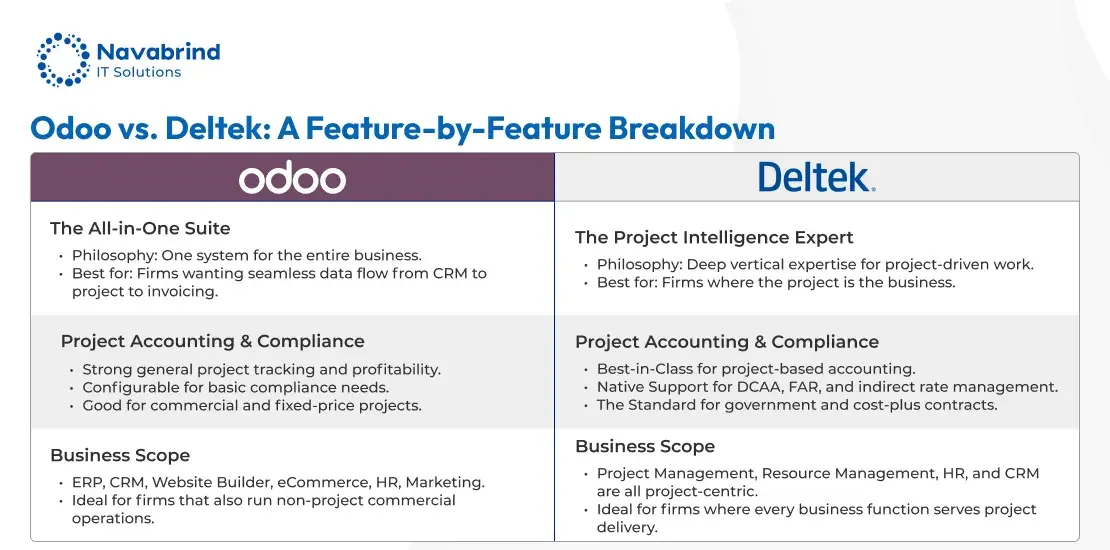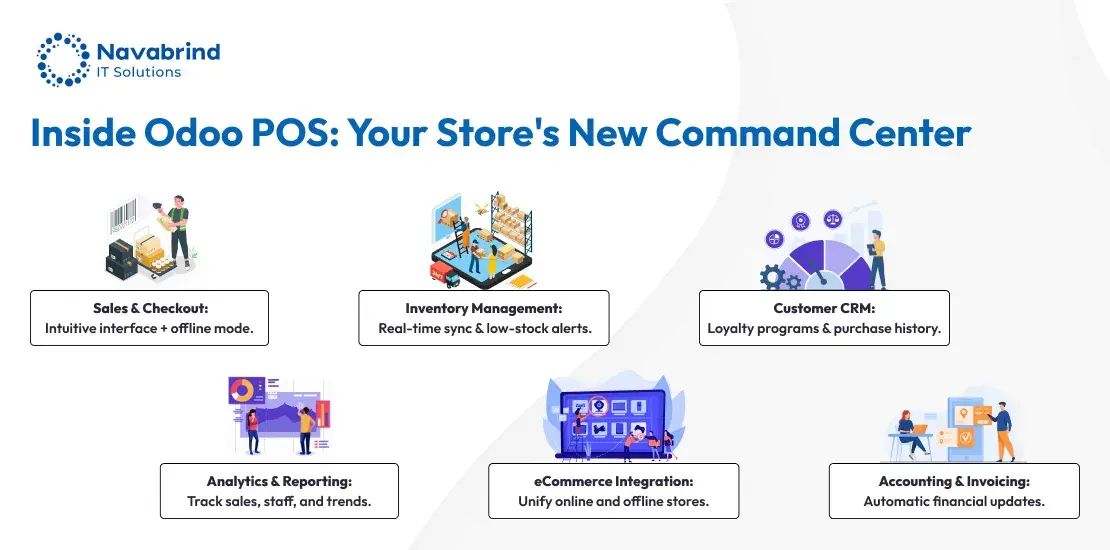Top ERP Systems in the USA: How Odoo Compares to NetSuite, SAP, and Microsoft Dynamics
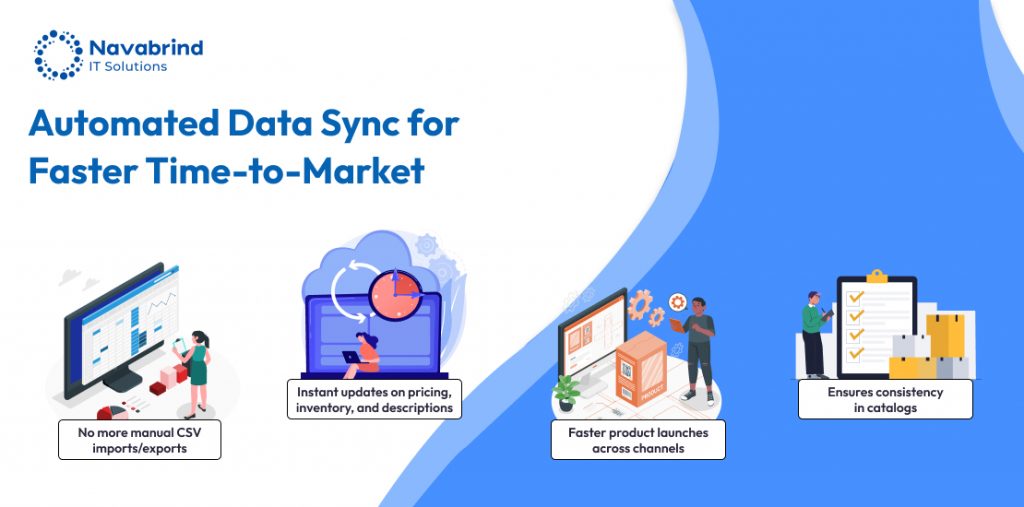
Enterprise Resource Planning (ERP) systems have become essential tools for companies in the United States who are striving for operational efficiency, data accuracy, and cross-functional integration. From streamlining manufacturing processes to improving financial oversight and customer relationship management, ERP adoption in the USA has grown steadily across industries. However, the market is awash with numerous options, and choosing the right ERP system has become a strategic decision— especially for companies aiming to align their technology with their size, sector, and future growth plans.
A critical observation from recent market trends is the growing need for industry-specific ERP systems, particularly for manufacturing companies in the USA. Many small and mid-sized businesses (SMBs) seek platforms that are both robust and flexible without the high cost or complexity of traditional enterprise software. As a result, ERP comparison in the USA has become a common starting point for businesses evaluating platforms like Odoo, NetSuite, SAP, and Microsoft Dynamics.
This blog post offers a detailed Odoo vs NetSuite vs SAP vs Dynamics comparison to help US businesses make an informed decision. We’ll look at core capabilities, pricing models, deployment options, industry fit, and customization flexibility. Whether you’re a small manufacturer looking for scalability, a mid-sized enterprise seeking integration, or a large firm requiring advanced automation, this guide highlights the best ERP for manufacturing in the USA, along with insights into the most affordable ERP systems for US companies.
If you’re conducting a cloud-based ERP comparison for US companies, this article will serve as a clear, business-focused evaluation that balances technical capability with practical outcomes. Through our Odoo ERP review for USA-based businesses, we aim to help decision-makers assess whether Odoo’s open-source flexibility and cost-effectiveness can outperform proprietary systems that often come with heavy licensing fees and rigid implementation models.
ERP Market Landscape in the USA
The ERP market in the United States has evolved rapidly in response to growing demands for operational agility, real-time data insights, and process automation. Across industries—particularly manufacturing, retail, and professional services—companies are prioritizing ERP implementations as foundational to their digital transformation strategies. The shift from legacy systems to cloud-based ERP solutions reflects a broader trend: U.S. businesses are increasingly seeking platforms that are cost-effective, scalable, and customizable.
Trends in ERP Implementation by Industry
In the manufacturing sector, ERP adoption is being driven by the need to streamline supply chains, manage inventory across multiple facilities, and comply with industry-specific quality regulations. The best ERP for manufacturing in the USA must support complex operations like bill of materials (BOM) tracking, shop floor control, and production scheduling. This is where solutions like Odoo have gained traction for their modularity and ease of customization—making them a strong contender in the ERP comparison USA landscape.
In retail, ERP systems are increasingly expected to integrate with POS, e-commerce, inventory, and CRM systems. Cloud-based systems like NetSuite have become popular due to their native omnichannel capabilities. However, many businesses are also exploring NetSuite alternatives for ERP in the United States such as Odoo, which offers similar functionality with greater flexibility at a lower cost.
In the services sector, ERP platforms are used to manage project lifecycles, human capital, and financials. The integration of tools like time tracking, invoicing, and CRM is critical. Solutions like Microsoft Dynamics and SAP Business ByDesign are often considered—but are typically more suitable for large enterprises due to licensing and implementation costs. Odoo, by contrast, is increasingly seen as an affordable ERP system for US companies, particularly in the SMB space.
Cloud ERP and Digital Transformation
The movement toward cloud-based ERP systems is reshaping the competitive landscape. Businesses are moving away from on-premises installations to cloud deployments that offer faster setup, automatic updates, and lower infrastructure costs. As such, cloud-based ERP comparison for US companies now weighs heavily on flexibility, total cost of ownership (TCO), integration capability, and ease of customization.
Odoo’s open-source architecture stands out here—providing a high degree of flexibility that proprietary platforms like SAP and Dynamics may lack. In particular, when considering how Odoo ERP compares to SAP in the USA, many companies find that while SAP offers robust enterprise-grade features, Odoo provides greater agility for growing businesses that need to respond quickly to market changes.
SMBs vs. Large Enterprises: ERP Requirements Differ
The ERP needs of small and mid-sized businesses (SMBs) differ significantly from those of large enterprises. SMBs typically require:
- Lower upfront costs and fast ROI
- Ease of use with minimal training overhead
- Scalable architecture to grow with the business
- Strong support and community
Odoo is often recognized as the best ERP for small and mid-sized manufacturing companies in the USA, offering a modular approach that lets businesses implement only what they need, then expand as necessary. For these businesses, Odoo vs Microsoft Dynamics for US businesses becomes a comparison of flexibility versus enterprise complexity—many opt for Odoo due to its lower cost and faster time-to-value.
Large enterprises with complex global operations might still lean toward solutions like SAP S/4HANA or Microsoft Dynamics 365 due to their deep industry vertical capabilities and robust compliance frameworks. However, these come with higher implementation costs, longer deployment timelines, and heavier reliance on system integrators.
Overview of the Top ERP Systems in the USA
When evaluating ERP solutions in the United States, businesses are often faced with a critical choice between functionality, scalability, and affordability. As digital transformation accelerates across sectors, choosing the right ERP platform is vital for long-term success. In this ERP comparison USA, we begin by examining four of the most prominent players: Odoo ERP, NetSuite, SAP and Microsoft Dynamics. Each offers unique strengths and trade-offs, especially for companies seeking the best ERP for manufacturing in the USA or affordable ERP systems for US companies.
These platforms are widely deployed by organizations of all sizes but are particularly prominent in mid-sized and large enterprises. Understanding how they compare with agile platforms like Odoo, and where they fit into the digital transformation roadmap of US companies, is essential—especially for businesses looking for NetSuite alternatives for ERP in the United States or evaluating Odoo vs NetSuite vs SAP vs Dynamics.
Odoo ERP
Odoo has quickly become a major contender in the American ERP landscape, especially among small and mid-sized businesses. One of the most attractive features of Odoo is its open-source architecture, which offers unparalleled flexibility and modularity. Whether a company requires CRM, manufacturing, inventory, accounting, or e-commerce capabilities, Odoo’s modular framework allows businesses to pick and choose the features they need and scale as they grow.
From a deployment perspective, Odoo supports cloud-based and on-premise ERP installations, making it versatile for a range of IT infrastructures and compliance needs. This makes Odoo ERP ideal in cloud-based ERP comparison for US companies, particularly those transitioning from legacy systems.
Odoo ERP offers two main editions:
- Community Edition (Free) – Ideal for startups and companies with technical expertise; provides core functionalities but lacks advanced features and official support.
- Enterprise Edition (Paid) – Includes full feature sets, mobile compatibility, advanced modules, and access to official support and updates.
Odoo is gaining significant traction in the US market due to its cost-efficiency and ability to be tailored to specific industry workflows. In fact, many Odoo ERP reviews in the USA cite its excellent value for money, intuitive interface, and rapid deployment capabilities. For manufacturers in particular, Odoo is considered among the best ERP for small and mid-sized manufacturing companies in the USA thanks to its production planning, BOM management, real-time inventory tracking, and multi-warehouse capabilities.
Compared to larger systems like SAP, how does Odoo ERP compare to SAP in the USA? For many SMBs, Odoo offers a more agile, cost-effective alternative without the complexity and overhead of enterprise-heavy solutions like SAP S/4HANA.
NetSuite
NetSuite has long held a dominant position in the cloud-first ERP market. It is especially well-regarded for its robust financial management tools, making it a favorite among service-based businesses, fast-scaling startups, and mid-market enterprises.
As a cloud-native ERP platform, NetSuite offers excellent accessibility, automatic updates, and integrations across its financial, CRM, and e-commerce modules. It’s commonly included in discussions around cloud-based ERP comparison for US companies for its reliability and mature infrastructure.
However, NetSuite has its limitations. Its licensing model can be expensive, especially as companies grow and need additional users or advanced modules. Customization, while possible, often requires skilled developers or certified partners, which adds to the total cost of ownership. For this reason, many organizations actively seek NetSuite alternatives for ERP in the United States, especially when customization flexibility and cost control are critical priorities.
In an Odoo vs NetSuite vs SAP vs Dynamics comparison, Odoo often emerges as the more affordable ERP system for US companies, particularly for manufacturers that need operational depth without enterprise overhead. While NetSuite excels in finance-led environments, it may fall short for complex manufacturing needs compared to platforms like Odoo or Dynamics 365.
SAP (Business One / S/4HANA)
SAP is one of the oldest and most established names in the ERP industry, offering a robust suite of solutions tailored to enterprises with complex, multi-layered operations. Its two primary offerings relevant to the US market include:
- SAP Business One: Designed for small to medium-sized enterprises, offering core ERP capabilities at a smaller scale.
- SAP S/4HANA: A powerful, in-memory ERP suite ideal for large enterprises seeking end-to-end digital transformation.
SAP’s strength lies in its legacy enterprise capabilities, with deep support for manufacturing, finance, supply chain, and compliance. It’s particularly suited to multinational corporations with highly structured operations and industry-specific needs. However, these advantages come with considerable trade-offs.
Complexity and implementation timelines are often cited as key challenges in SAP ERP reviews USA. Implementing S/4HANA can take many months depending on the scale of operations. This makes it less attractive for companies looking for quick deployment or agile transformation.
Pricing is another barrier for small and mid-sized firms. SAP’s licensing and maintenance costs are among the highest in the ERP space. Upgrades and support typically require long-term contracts with certified partners. Many US companies, especially in the SMB segment, seek affordable ERP systems, making Odoo ERP a viable alternative to SAP in the USA.
In the context of how Odoo ERP compares to SAP in the USA, Odoo’s modular approach, lower cost of ownership, and ease of customization make it a more flexible choice, especially for businesses that prioritize speed, adaptability, and innovation over rigid structure.
For manufacturers evaluating options, Odoo is also recognized as one of the best ERP for manufacturing USA, offering BOM management, shop floor control, and inventory integration at a fraction of SAP’s cost.
Microsoft Dynamics (Business Central / Finance & Operations)
Microsoft Dynamics has become a strong contender in the US ERP market, especially for companies embedded within the Microsoft ecosystem. It offers two main products:
- Dynamics 365 Business Central: Targeted at small and medium-sized businesses looking for an all-in-one ERP and CRM platform.
- Dynamics 365 Finance & Operations: Geared toward larger businesses needing extensive financial, supply chain, and manufacturing management.
What sets MS Dynamics apart is its smooth integration with Microsoft tools such as Office 365, Teams, SharePoint, Power BI, and especially Azure cloud infrastructure. For companies already operating within Microsoft’s environment, the value proposition is clear: enhanced productivity, better collaboration, and native data sharing.
Another major advantage is customization through the Microsoft Power Platform. Tools like Power Apps, Power Automate, and Power BI enable businesses to create low-code workflows, automate business processes, and generate custom reports—all without heavy reliance on developers. This flexibility aligns Dynamics closely with modern digital transformation goals and is particularly appealing in cloud-based ERP comparison for US companies.
While Business Central offers relatively affordable entry-level pricing, costs can escalate as companies require more users or advanced functionality. This has led many mid-sized businesses to explore Odoo vs Microsoft Dynamics for US businesses as a comparative analysis.
In many cases, Odoo ERP is chosen as the best ERP for small and mid-sized manufacturing companies in the USA because it offers rich manufacturing capabilities, lower customization costs, and easier module additions without escalating subscription fees.
Compared to MS Dynamics, Odoo’s open-source core and strong US partner ecosystem allow for deeper customization and faster ROI. Businesses that want greater control over their ERP environment—without vendor lock-in—often find Odoo to be the better long-term fit.
Feature-by-Feature Comparison: Odoo vs NetSuite vs SAP vs Dynamics
|
Feature |
Odoo |
NetSuite |
SAP |
Dynamics |
|
Deployment Options |
Cloud/On-premise |
Cloud-only |
Cloud/Hybrid |
Cloud/Hybrid |
|
Modularity |
High |
Moderate |
High |
Moderate |
|
Cost & Licensing |
Low |
High |
High |
Mid to High |
|
Customization |
Flexible (open source) |
Limited |
Complex |
Custom via PowerApps |
|
User Interface |
Intuitive |
Standard |
Complex |
Familiar (Microsoft UI) |
|
Best Fit For |
SMBs & mid-market |
Mid-large service firms |
Large enterprises |
SMBs with MS ecosystem |
Odoo for Manufacturing Companies in the USA: The Ultimate ERP Solution
Manufacturing firms in the USA face unique challenges—global competition, supply chain disruptions, rising costs, and the need for operational efficiency. To stay ahead, manufacturers need an agile, cost-effective, and fully integrated ERP system that streamlines processes from procurement to production to delivery.
Odoo ERP has emerged as a top choice for US manufacturers, offering powerful tools for real-time inventory, production planning, quality control, and shop floor management—all while being highly customizable and scalable for businesses of all sizes.
Why Odoo is the Best ERP for Manufacturing Firms
1. End-to-End Production Control
Odoo’s Manufacturing Module provides complete visibility over production processes, including:
- Master Production Scheduling (MPS) & MRP – Automate material requirements planning to prevent shortages or overstocking.
- Work Order Tracking – Monitor shop floor operations in real time.
- Subcontracting & Outsourcing – Manage external suppliers seamlessly.
2. Real-Time Inventory & Warehouse Optimization
- Multi-Location Tracking – Manage raw materials, WIP, and finished goods across multiple warehouses.
- Automated Reordering – Set minimum stock rules to trigger purchase orders automatically.
- Barcode & RFID Scanning – Reduce manual errors and speed up operations.
3. Quality Control & Compliance
- Predefined Quality Checks – Set inspection points at different production stages.
- Non-Conformance Reports (NCR) – Track defects and implement corrective actions.
- Traceability & Lot Tracking – Essential for FDA, ISO, and other regulatory compliance.
4. Cost-Effective Customization & Scalability
Unlike rigid legacy ERPs (e.g., SAP, Oracle), Odoo offers:
- Modular Pricing – Pay only for the features you need.
- Open-Source Flexibility – Customize workflows without expensive development.
- Scalable for Growth – Easily add new factories, product lines, or integrations.
Choosing the right ERP solution is a strategic decision that affects every part of your business—from finance and manufacturing to customer service and logistics. If you’re exploring an ERP comparison in the USA, you’re likely considering leading options like Odoo vs NetSuite vs SAP vs Dynamics. Each has its strengths depending on your industry, size, and growth plans.
- SAP remains a go-to for multinational corporations with highly complex processes and global compliance needs, but it often comes with significant implementation costs and time.
- Oracle NetSuite is popular among growing SaaS and service-based firms, yet many mid-sized companies now seek NetSuite alternatives for ERP in the United States due to cost and customization limitations.
- Microsoft Dynamics 365 appeals to firms already entrenched in the Microsoft ecosystem but can become inflexible as your operations evolve.
If you’re a mid-sized firm looking for the best ERP for manufacturing in the USA, or an agile enterprise seeking a flexible, cost-effective system—Odoo ERP is a strong contender.
When comparing cloud-based ERP solutions for US companies, Odoo stands out as an affordable ERP system for US companies that doesn’t sacrifice functionality or scalability. With dozens of integrated modules—including CRM, Accounting, Manufacturing, PLM, Inventory, and eCommerce—Odoo is the only open-source ERP with the depth to rival enterprise platforms while offering the agility that SAP or Dynamics lack.
Compared to SAP or Microsoft Dynamics, Odoo delivers faster deployment, full ownership of data, no vendor lock-in, and lower total cost of ownership—all tailored to meet the compliance and operational needs of US-based industries. It is especially suited for the best ERP for small and mid-sized manufacturing companies in the USA, offering robust MRP, barcode scanning, vendor management, and shop-floor control at a fraction of the cost of larger platforms.
Navabrind IT Solutions is a certified Odoo Gold Partner. We specialize in Odoo ERP consultation, implementation, data migration, customization, integration, support, and training for US companies. Our team brings 12+ years of ERP experience across manufacturing, retail, electronics, distribution, digital commerce and other industries.
Frequently Asked Questions
Q1. What is the best ERP for small manufacturers in the USA?
For small manufacturers in the United States, Odoo stands out as one of the best ERP platforms due to its flexibility, modular structure, and affordability. It’s especially appealing for businesses seeking to digitize core operations like inventory, production, procurement, and accounting without being overwhelmed by high licensing or implementation costs. In the ERP comparison USA context, Odoo consistently ranks as a preferred choice for small and mid-sized manufacturing firms aiming to streamline operations, improve visibility, and scale with ease. Its ability to grow with the business makes it the best ERP for small and mid-sized manufacturing companies in USA.
Compared to legacy systems like SAP or Microsoft Dynamics, Odoo is far more accessible in terms of cost and complexity. When evaluating Odoo vs NetSuite vs SAP vs Dynamics, small manufacturers often find that NetSuite and SAP offer robust features but are priced for enterprise-level companies. These platforms may also require longer implementation timelines and more technical support. Odoo, on the other hand, provides a full suite of manufacturing tools—such as MRP, work center scheduling, PLM, and quality control—making it one of the best ERP for manufacturing USA. Its low barrier to entry makes it particularly attractive to small firms that need to move fast and keep costs under control.
Moreover, Odoo ERP reviews USA highlight how small manufacturers benefit from its easy-to-use interface and extensive app library. It integrates seamlessly with third-party logistics providers, eCommerce platforms, and IoT systems. As part of a growing ecosystem of cloud-based ERP comparison for US companies, Odoo also offers flexible hosting options—whether cloud, on-premise, or hybrid—ensuring that even the smallest manufacturers can adopt digital technologies without heavy infrastructure investments. This balance of power, price, and performance positions Odoo as a leading solution and a top NetSuite alternative for ERP in the United States.
Q2. How does Odoo compare to SAP and Microsoft Dynamics?
When it comes to comparing Odoo vs SAP vs Microsoft Dynamics, the key differences lie in flexibility, cost structure, and ease of implementation. Odoo is widely regarded as a lightweight, modular platform that allows companies to adopt only the features they need, with the ability to scale as operations grow. SAP and Dynamics, while powerful, often come with steep learning curves and higher licensing and implementation costs. This makes Odoo a smart choice in ERP comparison USA, especially for businesses that want rapid deployment and a faster ROI.
In the case of how does Odoo ERP compare to SAP in the USA, SAP is typically positioned for large, enterprise-level deployments with highly complex workflows. Odoo, by contrast, serves both small businesses and growing mid-market companies, offering enterprise-grade capabilities like advanced manufacturing, multi-company support, and real-time reporting—without the heavy infrastructure or licensing burden. Odoo’s open-source core also enables deep customization at a fraction of the cost, making it one of the most affordable ERP systems for US companies. This positions Odoo as a highly competitive SAP alternative for those seeking agility over legacy rigidity.
For US-based companies evaluating Odoo vs Microsoft Dynamics for US businesses, the same principles apply. Microsoft Dynamics offers strong integrations with the Microsoft ecosystem and is best suited for enterprises already embedded within that stack. However, Dynamics implementations can be costly and may require specialized consultants. Odoo, on the other hand, is praised in Odoo ERP review USA discussions for its lower total cost of ownership and rapid deployment timeline. For small and mid-sized businesses exploring cloud-based ERP comparison for US companies, Odoo’s flexibility, scalability, and affordability make it an increasingly preferred option in a market that demands adaptability and speed.
Q3. Is Odoo suitable for fast-growing companies in the US?
Yes, Odoo is exceptionally well-suited for fast-growing companies in the US due to its modular architecture, scalability, and cost-effectiveness. Whether you’re a small business scaling to mid-market or a mid-sized manufacturer expanding into new regions, Odoo allows you to start with the essential modules—like CRM, Inventory, Sales, and Accounting—and then seamlessly scale up to include Manufacturing, PLM, Field Services, and eCommerce as needed. In the context of ERP comparison USA, Odoo frequently emerges as a strong alternative to more rigid and expensive platforms such as SAP and NetSuite.
Odoo’s flexibility is especially beneficial for industries with complex or rapidly changing needs. For example, in the best ERP for manufacturing USA segment, fast-growing manufacturers find Odoo’s integrated MRP, quality management, and supply chain tools highly adaptable to evolving production volumes and supplier networks. Compared to SAP or Microsoft Dynamics, which often require expensive add-ons or external consultants for customizations, Odoo’s open-source foundation allows US companies to innovate rapidly and cost-effectively. This is why many regard Odoo as the best ERP for small and mid-sized manufacturing companies in USA.
Additionally, Odoo’s growing partner ecosystem in the United States ensures local implementation support and faster response times—factors that are critical for fast-growing businesses. Whether evaluating Odoo vs Microsoft Dynamics for US businesses or seeking cloud-based ERP comparison for US companies, Odoo consistently offers a high return on investment. Numerous Odoo ERP reviews USA point to how the platform grows with the business—making it not only a smart starting point but a long-term strategic platform.
Q4. What makes Odoo more affordable than NetSuite?
Odoo’s affordability compared to NetSuite stems from its flexible licensing model, open-source foundation, and lower total cost of ownership. Unlike NetSuite, which has a rigid per-user pricing model and charges for each module, Odoo offers a modular subscription where businesses pay only for the apps they use. This structure makes Odoo one of the most affordable ERP systems for US companies, especially for startups and growing enterprises that want to avoid bloated software costs. For organizations evaluating NetSuite alternatives for ERP in the United States, Odoo offers significant cost savings without sacrificing functionality.
Moreover, Odoo’s customization capabilities do not require deep-pocketed investments in proprietary development. Many Odoo modules are community-driven and can be tailored with minimal licensing impact. When comparing Odoo vs NetSuite vs SAP vs Dynamics, the customization costs for Odoo are considerably lower—especially when leveraging the expertise of Odoo partners in the USA. Odoo’s flexible deployment options—whether cloud-hosted, on-premise, or via Odoo.sh—also give businesses control over infrastructure costs, making it highly appealing in cloud-based ERP comparison for US companies.
Another key differentiator is implementation and maintenance costs. NetSuite implementations often run high due to specialized consultants and partner lock-ins. Odoo, with its open-source core and active global community, enables more competitive implementation rates and long-term support flexibility. This is why, in the Odoo ERP review USA landscape, many businesses emphasize not only Odoo’s functional strengths but also its long-term affordability and freedom from vendor lock-in—two critical factors for sustainable ERP adoption in the US market.
Q5. Can Odoo ERP handle compliance and tax regulations specific to the United States?
Yes, Odoo ERP is fully capable of supporting compliance and tax requirements specific to the United States. With built-in support for U.S. sales tax (including integrations with Avalara for real-time tax rate calculations), payroll compliance, and GAAP-compliant accounting, Odoo ensures businesses meet federal and state regulations. This makes it an increasingly popular choice in the ERP comparison USA landscape. Additionally, Odoo’s modular structure allows for customization based on specific compliance needs in industries like manufacturing, logistics, and retail—providing flexibility not always present in systems like SAP or Microsoft Dynamics.
In the broader context of Odoo vs NetSuite vs SAP vs Dynamics, Odoo stands out for its affordability and adaptability. While NetSuite and SAP offer robust compliance tools, they come with significantly higher licensing and customization costs. Odoo is a strong NetSuite alternative for ERP in the United States, especially for small and mid-sized manufacturing companies in the USA seeking localized compliance solutions without the overhead. Furthermore, Odoo’s cloud-based architecture is ideal for remote audits, tax reporting, and data traceability—positioning it well in cloud-based ERP comparisons for US companies.
Q6. What kind of support and localization does Odoo offer for US-based manufacturing and retail companies?
Odoo has made significant investments in localization for the U.S. market. For manufacturing companies, Odoo provides industry-specific features such as MRP, quality control, maintenance, and PLM—all integrated with accounting and inventory systems that adhere to U.S. standards. This positions it among the best ERP for manufacturing in the USA and a compelling choice in any ERP comparison USA list. For retail companies, Odoo offers localized POS systems, multi-warehouse management, and real-time sales analytics tailored for U.S. consumer behavior and logistics networks.
When evaluating Odoo vs Microsoft Dynamics for US businesses or exploring the Odoo ERP review USA, businesses often find that Odoo’s community and enterprise support models are more cost-effective and responsive, especially for growing operations. Odoo partners in the U.S. provide localized implementation, support, and training, making it a reliable choice for companies that want close collaboration. For those seeking affordable ERP systems for US companies, especially in competitive sectors like retail or D2C manufacturing, Odoo’s flexibility, low TCO, and growing ecosystem make it one of the top choices for ERP in the United States.
Schedule a conversation with us now!
Related Articles
-
Post
Odoo ERP vs. Metasfresh – Choosing the Right Fit for Your Food Business
Odoo ERP vs. Metasfresh – Choosing the Right Fit for Your Food Business December 22, 2025 Posted by: Tony Categories: Blog, Odoo ERP vs. Metasfresh No Comments In the competitive, regulated food industry, the right ERP isn’t a luxury—it’s the operational backbone of your entire business. It’s the system that manages your critical tasks: tracking -
Post
Odoo ERP vs. Deltek – Which ERP Fits Your Architecture, Engineering, Construction, or Consulting Firm?
Odoo ERP vs. Deltek – Which ERP Fits Your Architecture, Engineering, Construction, or Consulting Firm? December 11, 2025 Posted by: Tony Category: Odoo ERP vs Deltek No Comments Why Architecture, Engineering, Construction (AEC), and Consulting Industries Need ERP Systems ERP systems have become indispensable tools for Architecture, Engineering, Construction, and Consulting firms, which handle multi-faceted -
Post
Streamline Your Store: A Deep Dive into the Odoo Point of Sale System
Streamline Your Store: A Deep Dive into the Odoo Point of Sale System December 5, 2025 Posted by: Tony Category: Uncategorized No Comments The Heart of the Modern Retail Experience Picture this: a customer walks into your store, finds what she is looking for and is ready to buy. Your online store just received five
How can we help you?
Get in touch with a solutions consultant that can share best practices and help solve specific challenges.







